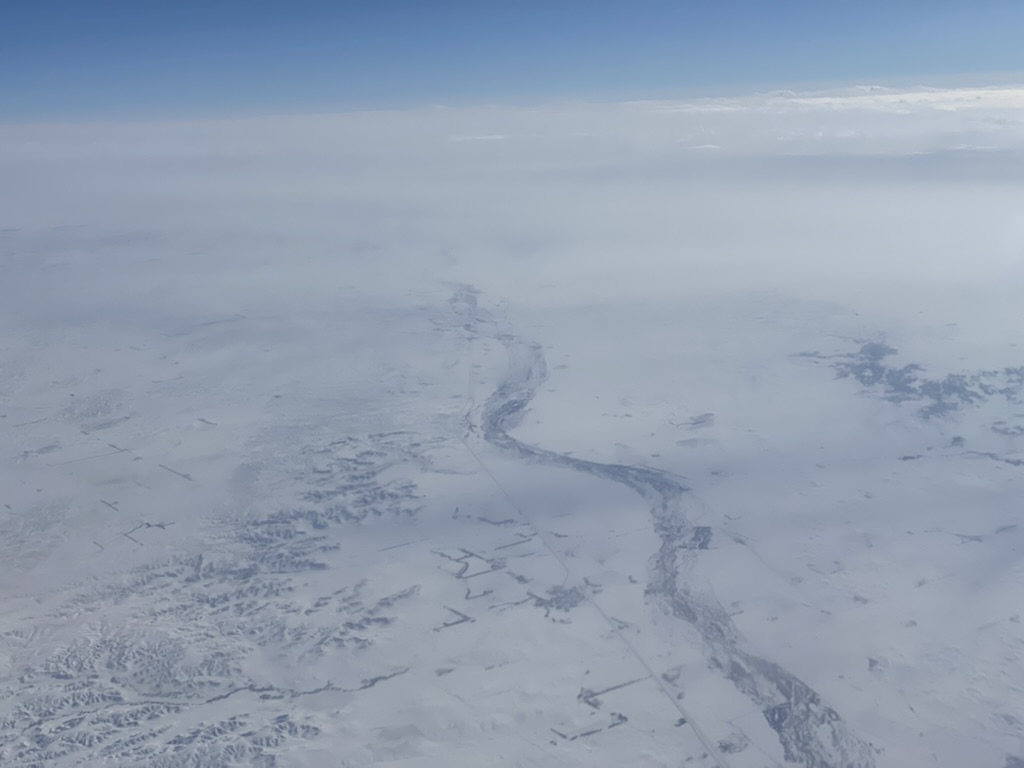
“In the United States there is more room where nobody is than where anybody is. That is what makes America what it is.”
Gertrude Stein
EDWARDS, Colo. — I flew from Bismarck, N.D., to Denver the other day to give a lecture. After the usual delays, the plane left Bismarck at about 10:30 a.m. About half an hour into the flight, between reading and dozing and typing some notes, for no apparent reason I glanced out the window. As if by synchronicity, there below me at that random moment was one of the most romantic and alluring places on the Great Plains — the Pine Ridge country that separates the northern plains from the high plains. In the snowscape below me I recognized the North Platte River and the broken country at and near the Pine Ridge. The massacre site at Wounded Knee could not be far off this patch of wild landscape. In this photograph (above) you are looking at an area of about forty miles by twenty miles. You can see a couple of roads, one of them prominent on the north side of the river. And you can see a handful of ranches and shelter belts, planted under grants from the Soil Conservation system. This photograph takes in all that my camera could embrace through the small, semi-opaque window of the regional jet hurtling over the plains at 400 miles per hour.
What struck me more than anything else was how empty the landscape was. Deer, rabbits, coyotes, pronghorn antelope, prairie dogs, foxes, owls, eagles, and maybe a few wolves live there, but almost no humans. Immediately I thought of John Steinbeck’s statement, early in Travels with Charlie, that we Americans live in a “monster country.” Or as Gertrude Stein put it, “In the United States there is more room where nobody is than where anybody is. That is what makes America what it is.” Thanks to the wizardry of today’s technology a: I was able instantly to take a photograph of what I saw below me (try that in 1984); and b: I was able to text the photo to a friend more than a thousand miles away who would immediately understand what the photograph signified with a caption, without accompanying text.
This is most of America, especially beyond the Mississippi River. There are vast essentially uninhabited sections of the country, and you don’t have to get very far away from the coasts to experience them. What is left of the romance of America is tightly bound up with these vast and empty spaces.
When I see them from the air, or for that matter see the side roads snaking off the highway I am on in my car, my urge is to turn off and explore these places. Even in my home state of North Dakota, which is merely the nineteenth largest state, I’m guessing that I have seen no more than 10 percent of it. There are paved roads I have never been on — a source of sadness to me. There are countless gravel roads that I have never been on. And yet I take out of the way roads everywhere I travel with the express purpose of getting to know North Dakota as much as I possibly can.
Stein is right. This IS America. And even in a modest little city like Bismarck, it is possible to forget that fact most of the time. As Thoreau might say, if I had remembered that, I might have avoided some mistakes.
